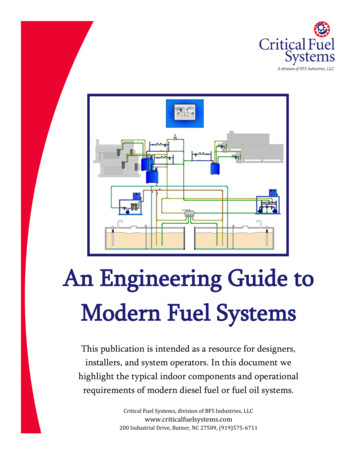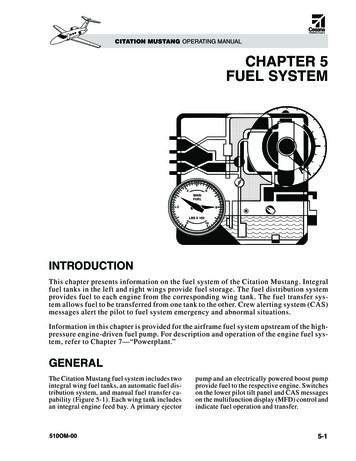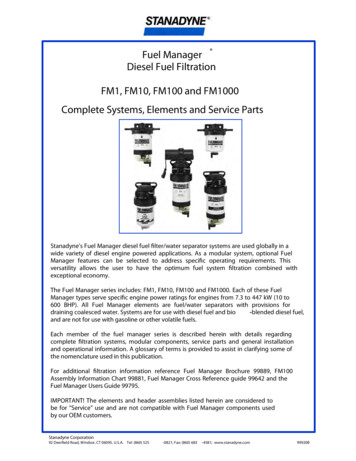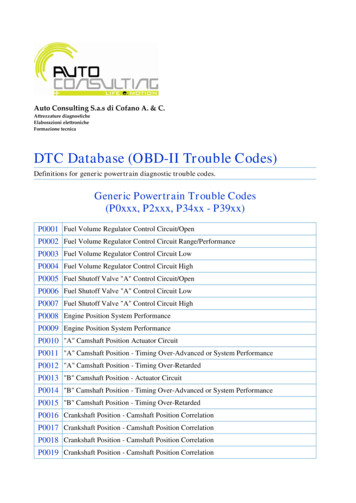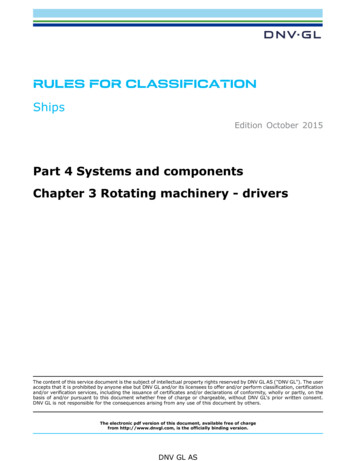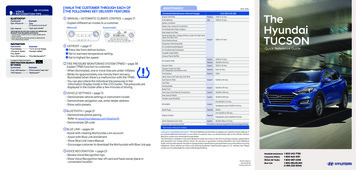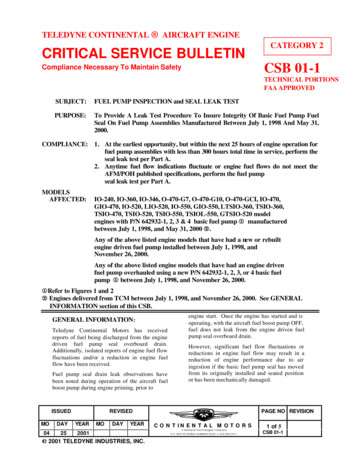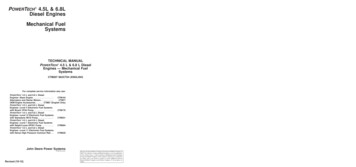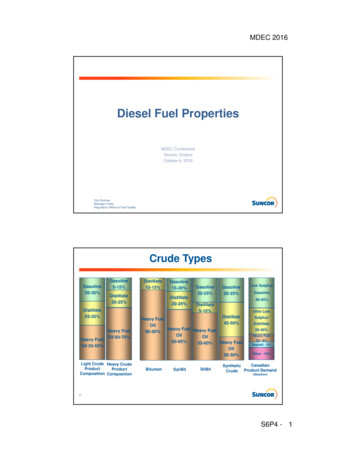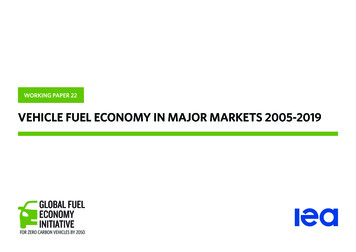
Transcription
WORKING PAPER 22VEHICLE FUEL ECONOMY IN MAJOR MARKETS 2005-2019
INTERNATIONAL ENERGY AGENCYThe IEA examines the full spectrum ofenergy issues including oil, gas andcoal supply and demand, renewableenergy technologies, electricitymarkets, energy efficiency, access toenergy, demand side managementand much more. Through its work, theIEA advocates policies that willenhance the reliability, affordabilityand sustainability of energy in its 30member countries, 8 associationcountries and beyond.Please note that this publication issubject to specific restrictions thatlimit its use and distribution. Theterms and conditions are availableonline at www.iea.org/t&c/This publication and any map included herein arewithout prejudice to the status of or sovereigntyover any territory, to the delimitation ofinternational frontiers and boundaries and to thename of any territory, city or area.Source: IEA. All rights reserved.International Energy AgencyWebsite: www.iea.orgIEA member countries:AustraliaAustriaBelgiumCanadaCzech andsNew ZealandNorwayPolandPortugalSlovak RepublicSpainSwedenSwitzerlandTurkeyUnited KingdomUnited StatesIEA association eSouth AfricaThailand
AbstractGlobal Fuel Economy Initiative 2021AbstractThis report presents the latest update to the Global Fuel EconomyInitiative’s biannual benchmarking report on light-duty vehicle sales.The report tracks the progress of fuel economy of new light-dutyvehicles, providing the latest insights based on a rich datasetcovering about 85-90% of global light-duty vehicle sales andextending from 2005 to 2019. It leverages these data and IEAmodelling to inform policy makers on the policies that would beneeded to align the pace of light-duty vehicle efficiencyimprovements with climate ambitions. To inform the Global FuelEconomy Initiative (GFEI) targets, which go beyond tailpipeemissions, this report extends the scope of analysis from rated fueleconomy and tailpipe emissions to consider the current andpotential performance of different light-duty vehicle fuel-powertrainoptions on a well-to-wheel basis; quantifying greenhouse gasemissions incurred in producing, transporting and delivering bothconventional transport fuels (derived from oil and gas), and energyPAGE 3IEA. All rights reserved.carriers such as electricity and hydrogen.
AnnexesGlobal Fuel Economy Initiative 2021Representatives of the Global Fuel Economy Initiative (GFEI)partner organisations reviewed the manuscript, including: RichardClarke and Sheila Watson of the FIA Foundation, Georg Bieker ofICCT, Pierpaolo Cazzola, Matteo Craglia and Stephen Perkins ofAcknowledgmentsThis publication was prepared by the Energy Technology PolicyDivision within the Directorate of Sustainability, Technology andOutlooks of the International Energy Agency (IEA). The study wasdesigned and directed by Timur Gül (Head of the EnergyTechnology Policy Division) and guided by Araceli Fernandez(Head of the Technology Innovation Unit). The analysis andproduction was co-ordinated by Leonardo Paoli and Jacob Teter.The report was prepared with the support of the FIA Foundation, theSecretariat of the Global Fuel Economy Initiative (GFEI).the International Transport Forum and Julie Witcover of UC Davis.Peer reviewers provided essential feedback to improve the qualityof the report. They include: Koichiro Aikawa, Katsutoshi Nosaki andYuichiro Tanabe (Honda); Carina Alles (Combustion TCP); VincentBenezech (Veitch Lister Consulting); Viviana Cigolotti (ENEA);François Cuenot (UNECE); Michael Dwyer (EIA); Hiroyuki Fukuiand Max Parness (Toyota); Stephen Hsu (Advanced Materials forTransport TCP); Hiroyuki Kaneko and Gen Saitou (Nissan); SujithKollamthodi (Ricardo AEA); Martti Larmi and Yuri Kroyan (AaltoUniversity); Philip J. Lenart (ExxonMobil); William Lilley (Aramco);The structure of this report, the methodological choices, theselection of indicators and their analysis were jointly developed byLeonardo Paoli, Jacob Teter, Elizabeth Connelly, Ekta Meena Bibraand Jacopo Tattini. Leonardo Paoli carried out the IEA databaseupdate for this analysis, supported by Ciril Wakounig. ElizabethConnelly, Ekta Meena Bibra and Jacopo Tattini carried out theanalytical work and drafting underpinning well-to-wheel greenhousegas emissions accounting (Chapters 3 and 4). Hidenori Moriya andZifeng Lu and Michael Wang (Argonne National Laboratory); PaulLucchese (Hydrogen TCP); Paul Miles (Combustion TCP); HidetakaNishi (METI); Luc Pelkmans (Bioenergy TCP); Joseph Poligkeit(Volkswagen); Taylor Reich (ITDP); Robert Spicer (BP); BiankaUhrinova (Equinor); Kim Winther (Advanced Motor Fuels TCP);Uwe Zimmer (Infineum).Alison Pridmore contributed to the policy analysis (Chapter 2).Praveen Bains, Tae-Yoon Kim, Christophe McGlade and UweRemme of the IEA provided data and insights into well-to-tank fuelsupply pathways. Sarah McBain provided valuable support, mostnotably for the country reports. Apostolos Petropoulos and KeisukeSadamori of the IEA provided valuable feedback.Andrew Johnston was the primary editor of this report and ErinCrum carried responsbility for copy-editing. The authors would liketo thank the IEA Communications and Digital Office, in particularJon Custer, Astrid Dumond and Therese Walsh, for their assistancein producing the report and associated online tools.PAGE 4
Executive summaryGlobal Fuel Economy Initiative 2021Executive summaryPAGE 5
Executive summaryGlobal Fuel Economy Initiative 2021Achieving the 2030 target of the Global Fuel Economy Initiative requires almost tripling thespeed of progress since 2005The aim of this report is to track the progress of fuel economy ofnew light-duty vehicles across the globe to inform policy makers onthe effectiveness of relevant policies in place towards the pace offuel economy improvements to be in line with climate ambitions.The report measures progress against the Global Fuel EconomyInitiative (GFEI) target of halving the fuel consumption of newremained unchanged between 2017 and 2019, following arelaxation of fuel economy standards. In contrast, average fuelconsumption declined in China, driven by fuel economy standards,and in emerging markets and developing economies.Total improvements are significantly lower than the 2.8% yearly fueleconomy improvements needed to meet the Global Fuel EconomyInitiative target of halving the fuel consumption of new light-dutyvehicles by 2030 relative to 2005. Given slow progress to date,achieving this target will require fuel consumption to decrease by4.3% per year on average from 2019 to 2030 – a near tripling of theaverage annual pace of improvement since 2005. Such atransformation in fuel consumption trends can be brought about onlyby stronger policies that increase the market shares of efficientelectric cars as well as global adoption of state-of-the-art efficiencytechnologies in internal combustion engines.light-duty vehicles by 2030, relative to 2005.The urgency of policy action is underlined by the fact that fueleconomy progress is stalling. The average rated fuel consumptionof new light-duty vehicles fell by only 0.9% between 2017 and 2019(the latest year for which data are available), to 7.1 litres of gasolineequivalent per 100 kilometres (Lge/100 km). This drop is far smallerthan the 1.8% annual average reduction between 2010 and 2015.The three major car markets – the People’s Republic of China(hereafter, “China”), the European Union and the United States –accounted for 60% of global sales of light-duty vehicles in 2019,which totalled 90 million, down 7% from 2017. Between 2017 and2019, average rated fuel consumption rose in Europe, as theEuropean Union’s CO2 emission regulations did not require anyfurther improvement until 2020, when rated emissions from newvehicles declined by more than 10% year-on-year. In the UnitedStates, the average fuel consumption of new light-duty vehiclesThe importance of electric vehicles is underlined by the fact thatCO2 emissions fell faster than fuel economy between 2017 and2019 because market penetration of electric vehicles rose. Globalaverage rated CO2 emissions in 2019 were 167 grammes ofCO2 per km (g CO2/km), a 1.6% decrease from 2017.PAGE 6
Executive summaryGlobal Fuel Economy Initiative 2021To meet the GFEI 2030 target, countries need to alignlegislation on fuel economy with their climate pledges.Countries’ current and stated policies are not sufficient to meet theGFEI 2030 target, as shown by the International Energy Agency(IEA) Stated Policies Scenario. If countries align their fuel economystandards and market adoption of zero-emission vehicles with theirplans to achieve their nationally determined contributions and/or netzero emissions pledges, however – as shown in the IEA AnnouncedPledges Scenario – they can meet the 2030 GFEI target.Only the Net Zero Emissions by 2050 Scenario meets the GFEI2050 target. The GFEI’s long-term, more ambitious target is toreduce well-to-wheel emissions of light-duty vehicles by 90% by2050, relative to 2005. In the Announced Pledges Scenario, theseemissions decline by only about 40% by 2050. Meeting the GFEIgoal for 2050 requires an energy and transport sectortransformation of the scale, speed and depth depicted in the IEANet Zero Emissions by 2050 Scenario. The fact that only the NetZero Scenario can achieve this ambition highlights the need forrapid, targeted action on many fronts, including improving vehicleefficiency; deploying zero-emission vehicles; decarbonisingelectricity and hydrogen supply; encouraging shifts to other modesof transport; and managing travel demand.PAGE 7
Executive summaryGlobal Fuel Economy Initiative 2021Improvements in average new fuel consumption and tailpipe CO2 emissions are stallingLge/100 kmAverage fuel consumption of new light-duty vehicle sales, 010201120122013Developing and Emerging2014Japan201520162017United States20182019WorldIEA. All rights reserved.Notes: Rated fuel consumption was converted from national test cycles to estimated performance on the Worldwide Harmonized Light-Duty Test Cycle using the zero-interceptconversion equations developed by the International Council on Clean Transportation (2014). The GFEI dataset covers 85-90% of the light-duty vehicle market. EU27 refers to thecurrent 27 member countries of the European Union. Developing and Emerging refers to emerging markets and developing economies (Argentina, Brazil, Chile, Egypt, Malaysia,Mexico, Peru, the Philippines, the Russian Federation and Ukraine).Source: IEA analysis based on IHS Markit database.PAGE 8
Executive summaryGlobal Fuel Economy Initiative 2021IEA Scenarios highlight the policy ambition and technology progress needed to meet GFEItargetsWell-to-wheel greenhouse gas emissions of light-duty vehiclesRated fuel economy of new light-duty vehiclesGt CO2-eqLge/100 km (WLTC)Trajectories of rated fuel economy (left) and well-to-wheel emissions of light-duty vehicles against GFEI targets and IEA Scenarios1085Net Zero by 2050 0152020202520302035Net Zero Emissions by 20502040204520500200520102015Announced Pledges Scenario202020252030203520402045Stated Policies Scenario2050GFEI targetsIEA. All rights reserved.Note: Rated (tank-to-wheel) fuel economy normalised globally to the Worldwide Harmonized Light-Duty Test Cycle (WLTC).Source: IEA Mobility Model (2021 September version).PAGE 9
Executive summaryGlobal Fuel Economy Initiative 2021Vehicles are getting larger and more powerful, eroding progress on fuel economy. But even ifthey were not, we still would not be on track to achieving the 2030 GFEI fuel economy target.Improvements in fuel economy have slowed recently for two mainreasons: vehicles are becoming ever larger and more powerful, andefficient engines have not been adopted quickly enough tocompensate. At the same time, efficiency gains in conventionalinternal combustion engine vehicles are slowing down as theirremaining efficiency potential becomes more expensive andtechnically difficult to exploit.Increasing vehicle size and power has eroded as much as 40% ofthe fuel consumption improvements that would otherwise haveoccurred thanks to technical advances in vehicles and engines.Even if vehicles had not grown in size and power, however, theworld would still not be on track to meet the GFEI targets, astechnical improvements to conventional engines are not sufficientand their progress is slowing.Larger and more powerful carsAlternative powertrains can deliver strong emissionsreductionsBetween 2010 and 2019, sales-weighted average new light-dutyvehicles became 6.2% heavier, 20% more powerful and had a 7%larger footprint, with the most rapid increases in China. A key causeof this trend has been a shift from cars (sedans) to SUVs and lighttrucks. As SUVs are larger and heavier than conventional cars, theyrequire more power and consume on average nearly one-third morefuel than a medium-sized car. SUVs’ global share of new light-dutyvehicle sales rose from 20% in 2010 to 44% in 2019. Even inmarkets with high SUV sales, such as the United States, SUVscontinue to claim a larger share of the market. In Japan, on theother hand, the trend towards larger and heavier vehicles has beenfar more muted, in part due to longstanding policies promoting verysmall “kei-cars”. In addition, a high proportion of new cars sold arehybrid electric vehicles – 20% in 2019. As a result of these trends,the rated fuel economy of new light-duty vehicles sold in Japan hascontinued to improve.Hybrid electric vehicles deliver on average about one-third lowerfuel consumption than conventional gasoline internal combustionengine vehicles and offer a cost-effective option to considerablyimprove fuel economy of conventional vehicles. Battery electricvehicles achieve efficiencies two to four times higher than internalcombustion engine vehicles, with zero tailpipe CO2 or pollutantemissions. The energy and fuel efficiency of plug-in hybrids areintermediate, and depend critically on drivers’ charging and drivingpatterns. In 2019, only small shares of the light-duty vehicle markethad been claimed by hybrid (3%), plug-in hybrid (1%) and batteryelectric vehicles (1%), so they had little impact on overall emissionsperformance. But this is likely to change over the current decade.PAGE 10
Executive summaryGlobal Fuel Economy Initiative 2021Increasing vehicle weight and power have eroded up to 40% of improvements in fuel economyDecomposition of fuel consumption trends, 2010-2019Lge/100 kmUnited hnical improvements201902010Powertrain changes20196.55.72010201930Vehicle attributes changesIEA. All rights reserved.Note: Technical improvements refer to the decrease of fuel consumption in each powertrain, excluding the effect of changing vehicle weight and power. (The powertrain comprises theengine, transmission, driveshafts, differential and axles.) Powertrain changes refer to the impact on fuel economy due to changing sales shares of powertrains. Vehicle attributes referto the change in fuel consumption due to changing vehicle attributes (weight and power). The decomposition methodology is taken from Craglia and Cullen (2019). Europe includesFrance, Germany, Italy and the United Kingdom.Source: IEA analysis based on IHS Markit database.PAGE 11
Executive summaryGlobal Fuel Economy Initiative 2021Battery electric vehicles had the lowest global average greenhouse gas emissions across alllight-duty vehicle segments in 2019 and in 2030 projectionsIntegrating well-to-wheel greenhouse gas emissionsKey insights from extending the scope to well-to-wheelsComparing the greenhouse gas emissions impacts of vehiclesacross different fuel-powertrain options requires looking beyondtheir rated tailpipe CO2 emissions. A coherent and completecomparison requires analysing the emissions incurred across theentire life cycle, and includes both the “fuel-cycle” or “well-to-wheel”emissions (those incurred in supplying fuels and in vehicleoperations), and “vehicle-cycle” emissions – those incurred inmanufacturing vehicles and disposing of them at the end of their life(including recycling).The analysis shows that compared with the potential to reduce thecarbon intensity of electricity, there is limited scope for reducing thewell-to-tank emissions incurred in supplying oil products and naturalgas. Moreover, the well-to-tank portion accounts for only 14% to18% of total well-to-wheel greenhouse gas emissions ofconventional internal combustion engine vehicles.In extending the analytical scope to a well-to-wheel basis, this reportis a first step in extending the scope of the GFEI benchmarkinganalysis to include the emissions associated with producing,deployment of renewables and other low-carbon power generationand hydrogen production technologies are the foundation fordecarbonisation across the energy sector (and not only for zerotailpipe-emission light-duty vehicles). In all regions and in allscenarios, the tank-to-wheel emissions of electricity decrease by2030. Global tank-to-wheel emissions from supplying electricitydecline by 2030 from the 2019 level by more than 25% in the StatedBy contrast, for battery electric and fuel cell electric vehicles,emissions incurred in producing and delivering electricity andhydrogen constitute all operational (well-to-wheel) emissions. Rapidtransporting and delivering transport fuels to vehicles. 11Previous IEA publications, including the Global EV Outlook 2019 and The Role of CriticalMinerals in Clean Energy Transitions, compare the greenhouse gas emissions incurred bydifferent light-duty vehicle powertrains on a full life-cycle basis. The analysis upon which thisreport builds integrates the well-to-tank greenhouse gas emissions incurred in providing currentand future transport fuels into the IEA Mobility Model. Emissions incurred at each step along thefuel supply chain are estimated using IEA databases and modelling tools, as well as theGreenhouse Gases, Regulated Emissions, and Energy Use in Technologies (GREET) tooldeveloped by Argonne National Laboratory. Variability in well-to-tank greenhouse gas emissionsacross regions and technologies, as well as projections of how these develop in IEA scenarios,were developed for current and future potential road transport fuels.PAGE 12
Executive summaryGlobal Fuel Economy Initiative 2021Policies Scenario, 35% in the Announced Pledges Scenario andto change as governments continue to adopt additional policies todecarbonise the power sector as a means to meet their long-termdecarbonisation targets.75% in the Net Zero Emissions by 2050 Scenario.Specific well-to-wheel greenhouse gas emissions, estimated ingrammes of CO2 equivalent per kilometre (g CO2-eq/km) for eachfuel-powertrain combination over the fleet average lifetime, varyconsiderably across vehicle segments and regions, as well as byThis is reflected by the Announced Pledges Scenario, in whichbattery electric vehicles offer the deepest carbon reductions on awell-to-wheel basis in every instance, thanks to rapid reductions inthe carbon intensity of electricity generation. The clear couplingbetween power sector decarbonisation and battery electric vehiclesprovides a strong rationale for promoting battery electric vehicles asa technology for decarbonising light-duty vehicle operations to meetscenario.Emissions performance varies most widely in conventional gasolineand diesel internal combustion engine vehicles, reflecting the rangeof models and sizes sold in different markets.climate ambitions.For vehicles sold in 2019, a clear rank order in terms of globalaverage well-to-wheel greenhouse gas emissions performance isevident in the Stated Policies Scenario. Battery electric vehicleshave the lowest emissions, followed by plug-in hybrids andhydrogen fuel cell electric vehicles. Hybrid vehicles have the lowestwell-to-wheel emissions among compressed natural gas, diesel andgasoline internal combustion engines.The well-to-wheel greenhouse gas emissions of fuel cell electricvehicles vary depending mainly on how hydrogen is produced.Currently, well-to-wheel emissions of fuel cell vehicles driving onhydrogen produced via coal gasification can be as high as those ofgasoline internal combustion engine vehicles, while those usinghydrogen from natural gas steam methane reformation achievewell-to-wheel greenhouse gas emissions on par with hybrid electricvehicles. By 2030 in the Announced Pledges Scenario, as more andmore hydrogen is produced through electrolysers powered at leastThis rank order does not hold across all regions and all scenarios.In the Stated Policies Scenario, hybrid vehicles can emit less thanbattery electric vehicles sold in 2019 in those regions in which theelectricity mix relies particularly heavily on coal, although this is setin part via renewables, fuel cell vehicles in some regions can alsooffer near-zero well-to-wheel emissions.PAGE 13
Executive summaryGlobal Fuel Economy Initiative 2021Average rated fuel economy performance and well-to-tank carbon intensity of supplying fuelsdetermine well-to-wheel greenhouse gas emissions intensityWell-to-wheel greenhouse gas emissions ranges across regions and countries in the Stated Policies Scenario and Announced PledgesScenarioGASOLINEICEDiesel ICEGlobal weighted averageCNG ICEGasoline HEVCity car segmentGasolinePHEVBEVFCEVGASOLINEICEDiesel ICECNG ICEGasoline 0APS400STEPSAverage lifetime emissions for vehicles sold in 2030400STEPSgCO₂-eq/kilometreAverage lifetime emissions for vehicles sold in 2019FCEVLarge SUV / pick-up segmentIEA. All rights reserved.Notes: STEPS Stated Policies Scenario; APS Announced Pledges Scenario; NZE Net Zero Emissions by 2050 Scenario; ICE internal combustion engine; CNG compressednatural gas; HEV hybrid electric vehicle; PHEV plug-in hybrid electric vehicle; BEV battery electric vehicle; FCEV fuel cell electric vehicle. Black bars show the global weightedaverage well-to-wheel greenhouse gas emissions performance. Coloured columns show the range of performance across all five regions covered in detail in this report (China, Europe,the United States, Japan, and developing and emerging countries). Grey bars (2019 STEPS only) show the global weighted average performance of each powertrain in the city carsegment (lower bars) and large SUV segment (upper bars), respectively (except for CNG ICE vehicles and FCEVs, where bars show minimum and maximum values across allsegments sold).Source: IEA Mobility Model, September 2021 version.PAGE 14
Executive summaryGlobal Fuel Economy Initiative 2021Battery electric vehicles have the lowest well-to-wheel emissions in all segmentsRated well-to-wheel greenhouse gas emissions of new light-duty vehicle sales worldwide by size segmentg CO₂eq / kilometreAverage lifetime emissions for vehicles sold in 2019Average lifetime emissions for vehicles sold in cated renewables5050Gasoline Diesel ICE CNG ICEICEBEVFCEVGasoline Diesel ICE CNG olineHEVSTEPSAPSSTEPSNZEAPSSTEPSNZEAPSSTEPS- 50NZE- 50APS0STEPS0STEPSNetFCEVIEA. All rights reserved.Notes: STEPS Stated Policies Scenario; APS Announced Pledges Scenario; NZE Net Zero Emissions by 2050 Scenario. CCUS carbon capture utilisation and storage. ForFCEVs, the red dots show the well-to-wheel greenhouse gas emissions incurred if hydrogen were to be produced via electrolysis with dedicated renewable sources. The height of thestacked column shows instead total well-to-wheel emissions of fuel cell electric vehicles considering current and projected share of hydrogen production pathways. Therefore, thedifference between the red column and the total indicates the theoretical well-to-wheel greenhouse gas emissions reduction potential of FCEVs. The carbon intensity of globalelectricity generation improves 26% between 2019 and 2030 STEPS and a further 30% between 2030 APS and 2030 STEPS. The utility factor of PHEVs is assumed to improve by sixpercentage points between 2019 and 2030 STEPS and by a further nine percentage points between 2030 STEPS and 2030 APS. 2019 STEPS considers a vehicle sold in 2019 withwell-to-tank intensities evolving in line with the STEPS trajectory, while 2030 APS considers a vehicle sold in 2030 with the well-to-tank intensities evolving in line with the APStrajectories.Sources: IEA analysis based on IHS Markit and the IEA Mobility Model (2021 September version).PAGE 15
Executive summaryGlobal Fuel Economy Initiative 2021Ten recommendations to align light-duty vehicle efficiency and greenhouse gas emissions withclimate goalsEnsure that regulations are based on and translate to realworld performance. Continued monitoring of the gap betweenScale up fuel economy standards and electrification targets tosupport announced net zero emissions ambitions. Marketdiffusion of vehicle efficiency technologies needs to nearly triple itspace to align operational greenhouse gas emissions of light-dutyvehicles with climate pledges. Standards are needed to promoteefficiency technologies in conventional internal combustion enginevehicles, and sales share targets for zero-emission vehicles. Whileseparate standards and zero-emission vehicles sales targets canreinforce each other, linking the two in a single regulation carriesthe risk of creating a regulatory loophole: zero-emission vehiclesales generate compliance credits, relaxing fuel economy standardsfor a manufacturer’s remaining fleet. This loophole can be closed byphasing out multiple credits for zero-emission vehicles as electricvehicle shares grow.rated and real-world performance is needed to ensure that fueleconomy standards have their intended impact. Digital technologiescan lower costs and increase effectiveness of compliancemonitoring, which should then inform future regulations.Implement policies to counter the growth in vehicle weight andpower. Governments can draw upon existing policies in countriessuch as France, Japan and Norway, where vehicles sold haveconsistently been among the lightest and most fuel-efficientworldwide. In addition to high fuel taxes and standards for CO2emissions and fuel economy, these countries subsidise and/or taxvehicles according to their weight, size, or greenhouse gas andpollutant emissions, or a combination of these attributes.Phase out fuel subsidies and tax road fuels at levels thatreflect their impacts on people’s health and the climate. Fueltaxes provide consumers with incentives to buy fuel-efficientvehicles and improve the market prospects for conventional hybridsand zero-emission vehicles. Subsidies that reduce the costs ofsupplying oil and gas products to the road sector should be phasedout, with careful consideration of social implications in view of theimpacts on poorer parts of the population. Road fuels should betaxed at levels reflecting their impacts on people’s health and theclimate.Harness the potential of zero-emission vehicles. Zero-emissionvehicles, and in particular battery electric vehicles, are the mostefficient, cost-effective and sensible technology options forachieving deep reductions in well-to-wheel greenhouse gasemissions in the light-duty vehicles sector. A broad suite of policiestargeting vehicle manufacturers can accelerate the market adoptionof zero-emission vehicles and ensure that they contribute their fullpotential to reducing emissions.PAGE 16
Executive summaryGlobal Fuel Economy Initiative 2021Policies promoting plug-in hybrid electric vehicles need toencourage charging and driving patterns that realise thesevehicles’ full potential to reduce greenhouse gas and pollutantemissions. Trip-making and charging patterns can have acan inform broad strategies for decarbonising the transport sector(including in light-duty vehicles), specific policy instruments can besttarget improvements specific to each of the many regulatedindustries involved in the fuels and vehicles supply chains.Designing and enforcing separate but in some cases mutuallyreinforcing regulatory and fiscal instruments for different stages ofthe life cycle is the most promising means to achieving the rapidsubstantial impact on real-world plug-in hybrid fuel economy andelectricity, resulting in wide variability between rated and real-worldperformance. The key to ensuring that plug-in hybrids are driven onelectricity will be to tie regulations and incentives more closely toaction needed.real-world performance.Promote the adoption of low-carbon fuels, especially directelectrification. Reducing the emissions from generating electricityHarmonise standards beyond the national level. Internationalco-operation and harmonisation of standards can lower the costs ofimplementing and enforcing regulations such as fuel economystandards. They also provide a valuable basis for engagement toachieve broader societal and environmental goals, including climateand producing hydrogen is the foundation of decarbonising theenergy sector, and of ensuring that zero-emission vehicles performto their full potential. Different policies are appropriate to integraterenewables and decarbonise electricity, depending on the currentstatus and mix of electricity generation and energy storage. Withinthe scope of fuel supply, policies that promote fuels with lowe
This report presents the latest update to the Global Fuel Economy Initiative's biannual benchmarking report on light-duty vehicle sales. The report tracks the progress of fuel economy of new light-duty vehicles, providing the latest insights based on a rich dataset covering about 85-90% of global light-duty vehicle sales and
